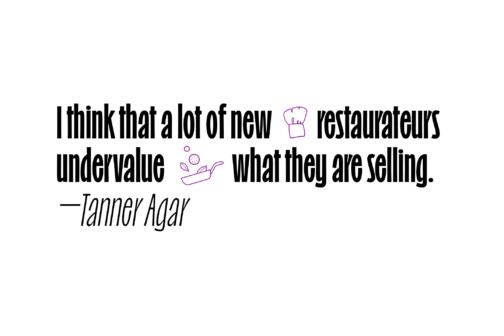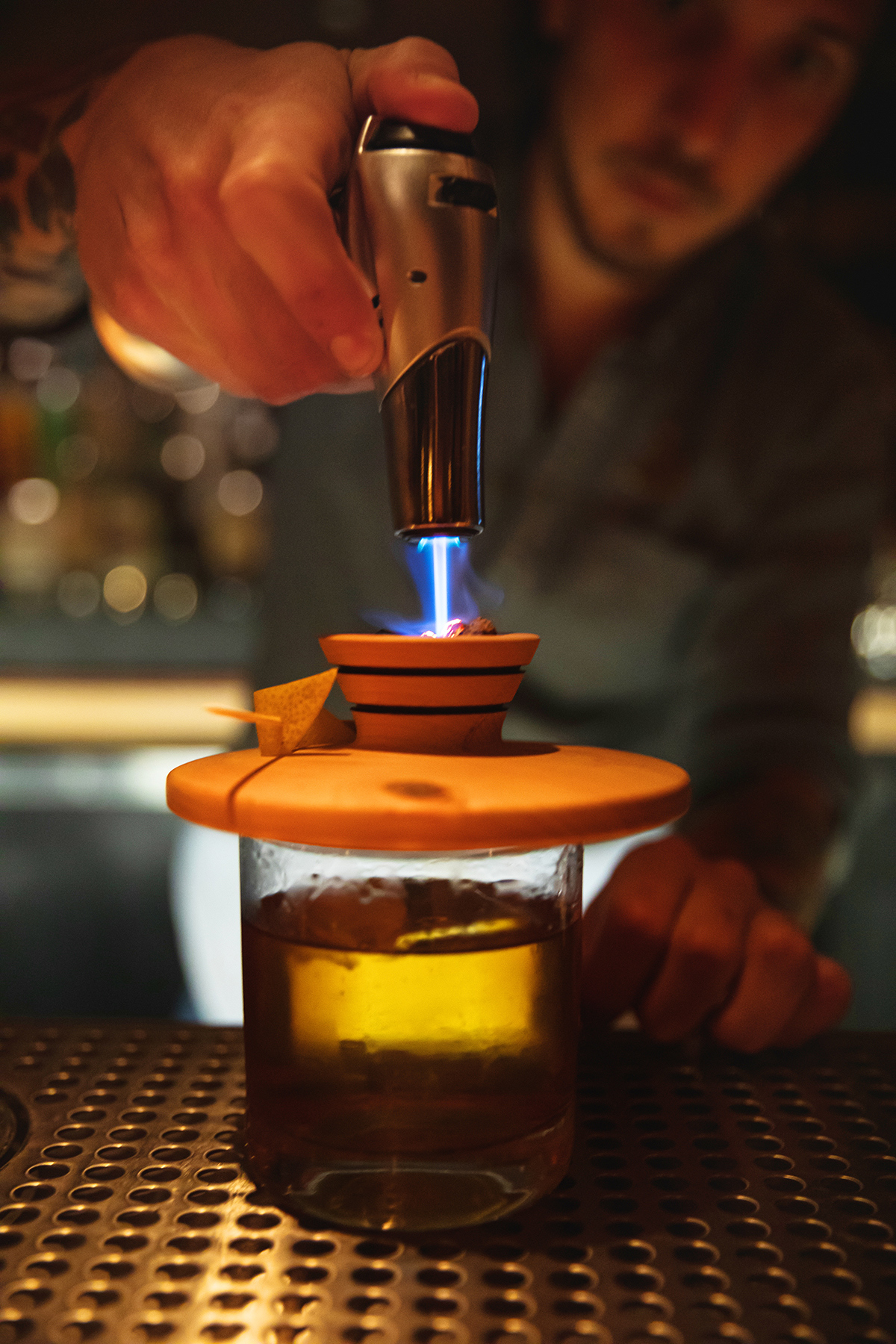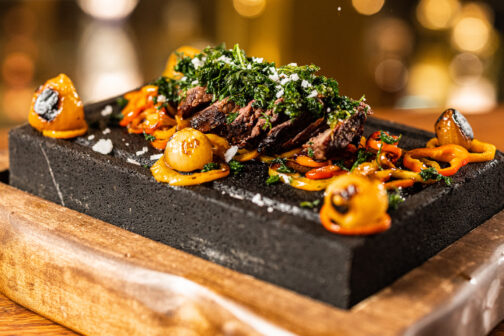Welcome to In the Weeds, our series in which Dallas restaurateurs explain behind-the-scenes aspects of the food service business—parts of the job that customers never see. Today we’re talking about how restaurants decide to change their prices in the face of inflation and rising supply costs.
Meet our experts:
- Sawsan Abublan, co-owner of fast-casual chain Shawarma Press
- Tanner Agar, co-owner of upscale restaurant Rye and cocktail bar Apothecary
- Jon Alexis, restaurateur behind TJ’s Seafood, Malibu Poke, Escondido, and Ramble Room
- J.R. Muñoz, owner of the bars Will Call and Elm Street Saloon
- Khanh Nguyen, restaurateur behind ZaLat Pizza and DaLat
- Brent and Juan Reaves, co-owners of Smokey John’s Bar-B-Q
None of these restaurateurs ever want to increase prices. They don’t do it to make a quick buck. But they also want their doors to stay open. Here’s what they have to say about the decision to change prices. (My comments and subject transitions are in italics.)
Read part one: What Must Happen Before a Restaurant Can Open?
Part two: How Do Restaurants Choose Their Locations?
Part three: What Are the Most Surprising Hidden Costs of the Restaurant Business?
First Rule of Restaurant Ownership: Know Your Food Costs
Calculating and adjusting food costs is an essential part of any food business. Even when inflation is not a problem, running a restaurant involves doing a lot of math. But the current economic climate requires a more active approach.
Tanner Agar: You want to keep food costs at or below 30 percent of net revenue. So the easiest pricing model is basically, what did we pay for the food, mark it up, problem solved.
Brent Reaves: We follow our food costs. We’re watching the prices of different categories, groceries, dairy. Meat, of course.
Khanh Nguyen: In the chain world, this is called taking pricing. They have it naturally built in to keep up with inflation. These are the things you’re not thinking about if you run a solo shop. You’ve got customers coming in, you’re making food. You don’t have somebody who sits in the back who [calculates inflation].
Brent Reaves: As we see that percentage begin to rise, we realize that we have to make an adjustment. You’re gonna hang in there as long as you can.
I think that’s what the consumer doesn’t understand. We’re at some point losing money compared to where we originally had this price. When we have these moments of inflation, you’re literally losing money every day.
Sawsan Abublan: We had a price increase this month that was unavoidable. We just could not hold that anymore. We wanted our customers to know that we have high quality products and we don’t want to compromise the quality. We tried our best not to increase all the menu items, so we took a hit on a couple and raised the ones that were a must.
Juan Reaves: You have to kind of forecast. Is this a trend? Sometimes there’s been times when we’ve been able to weather the storm, you see your margins start shrinking and shrinking and then it drops back. But it never goes back to where it was. At some point you’re gonna have to raise your prices.

Second Rule: Know Your Customers
The hardest part of the equation to calculate isn’t inflation. It’s psychology. What will customers be willing to pay? Do they understand that costs are changing? Will they stop visiting the restaurant if food costs keep rising? To make matters even more confusing, customers are willing to pay different prices for different cuisines, and that preference is not always based on food cost.
Juan Reaves: You see it with oil companies, their prices go up, but then their profits go up, and you see these huge windfalls. Our profits aren’t going up. We’re just trying to continue to provide what we provide and make a little bit of something. There’s a limit how much you’re gonna pay for a sandwich, and if we price ourselves beyond that limit, we’re not selling any more sandwiches.
Khanh Nguyen: We’ve got to balance what our customers can afford. Psychologically, if you’ve overdone it and it seems too expensive, you’re going to lose your customers. The balancing that is massive in terms of making the right decisions.
We analyzed all of our prices compared to Domino’s and Pizza Hut. While we are known as very expensive by everybody, as the premium player, we are $0.50 more expensive than Domino’s and less expensive than Pizza Hut. The only reason why people think we are so expensive is, instead of 12-inch and 14-inch, we sell a 14-inch and an 18-inch, which is 65 percent more [surface] area. They see the cost of the 18-inch and they’re like “oh my god!” when it’s just that much more pizza.
Jon Alexis: A higher cost product at a lower margin is our business model. If you want to compare the food cost of a $39 lobster roll and a $39 bowl of pasta, I know how that math works out. The ripoff is not at the top end of the market or the bottom end of the market. The ripoff is that $25 Sysco chicken breast that somebody is putting a crappy sauce on and charging $25. That’s the worst aspect of the food business: the fake good restaurant.
Brent Reaves: What people are willing to pay for barbecue is different. I went to La Madeleine last week. I got a quiche florentine and a little cranberry salad. $19.83. We have plates that are $19.95, and I’m talking about brisket, two sides, cornbread. How are we too expensive?
J.R. Muñoz: We’re not gonna make money on someone coming in and ordering wings and fries and having a Coke. Basically breaking even. If they’re taking them to go, with the to go packaging, the box and the bag, we’re kind of losing. I’m about to add a to-go fee.
Supply changes for specific ingredients can have the effect of changing a whole concept.
J.R. Muñoz: Our suppliers tried to talk us out of doing wings. What are we going to do? We’re known for that, that’s our thing now. And [the suppliers were] like, you guys should try chicken thighs. When we first started out a box of wings was like $75, $80. Now, they’re like $200.
When you’re doing that much product or you’re selling that much, your suppliers will know, “We got to keep [product] aside for this business.” I’m thinking that’s kind of where we’re getting with wings, because our rep follows us and he sees that we’re getting nominated for different awards. So he’s like, okay, these guys are for real. When he first was dealing with us, you could tell we were just kids to him.
Wings I think are gonna turn into like a delicacy like a ribeye steak is. Now you got to get wings because they’re expensive and hard to get. I’ve been to restaurants that say, “wings, market price,” like it’s fucking crab legs.
No, Not All Restaurants Are Overpriced
Contrary to what many customers may think, not all restaurants are overpriced, even amid the current price increases. In fact, many have the exact opposite problem.
Tanner Agar: I think that a lot of new restaurateurs undervalue what they are selling. It is so scary to release your restaurant out into the world, because the minute that it’s out there, people on Yelp are gonna write terrible things about you. They did it to us. Definitely a lot less now, but when we first started in McKinney, we were getting blasted. So you undervalue yourself, but then you don’t have enough money so that you can cover all these bills, which causes such a host of problems.
Jon Alexis: The challenge is we’re already underpriced. Part of it is chasing costs. Part of it is perceived value. This is why inflation sucks. You look at your competitors’ menus, and you say, gosh, I’m already not making my margin on this, if my competitor is charging $2 more, I guess that’s the market now.
The difference of $2 is not going to make diners not have a drink. If you have a $13 whiskey sour, and the place next door has a $15 whiskey sour—the diner is going to order that drink. It’s chicken and the egg. Every time another restaurant raises their prices and there is no pushback from the diner, it creates an arms race for the other restaurants.
The Influence of Delivery Apps
The pandemic has accelerated the growth of a new problem: third-party apps like Uber Eats, which often cost restaurants more money than they’re worth. But as new as these apps seem, they’re just a twist on the classic pizza delivery service, which makes up more of a big chain’s business than you might think.
Khanh Nguyen: We do so much of our business over the third-party delivery platforms, and delivery is expensive. You’re adding $15 with tip. Even though we’re not getting those dollars, and Uber and Doordash are getting those dollars, that’s what our customers have to pay. We have to know that somebody spent $40 for that pizza. You have to look at every pizza you make and ask, would you pay $40 for this pizza?
The big pizza chains are logistics companies and not pizza companies. They spend so much of their money on that delivery piece. [Delivery drivers] make $10-12 an hour just like you would pay somebody else, and then they get tips on top of that. [Chains] basically operate a second kitchen, in terms of cost. And they can do that because they’re so much more efficient. Their ingredients are cheaper, and their labor model is a conveyor belt. You load up a crust with toppings, load it onto the conveyor belt, and exact mediocre pizza comes out the other side. We’ve tried every conceivable conveyor belt oven that exists and it always makes the pizza mediocre. With our mission, that’s just not something we can ever touch. You don’t get the air bubbles, you don’t get the char, you don’t get the crispy. We just cannot touch their labor model.
One Last, Optimistic Thought
We’ll give the last word on pricing and price changes to Tanner Agar, who has a more hopeful message about how to build a successful restaurant.
Tanner Agar: I would rather pay exceptional people more money who can then turn ingredients that maybe didn’t cost as much into really interesting things. If I add my labor and my food cost budget, it might come out to the same as industry standard, but I can shift the proportion. Instead of being 50 food, 50 labor, I would rather have it be 40 food, 60 labor because then it follows my personal belief of having people, paying them as much as you possibly can, and allowing them to do interesting great things.
It bothers me when I go to a restaurant and to make it good, it’s all filet and it’s all truffles and it’s all caviar. If you’re a restaurant making something that is really great, out of stuff that’s cheap, that’s your win.
I remember one year I was working in Canada and the lobster population doubled, I don’t know what it was, the water temperature or whatever. So the price of lobster dropped like crazy. The price of lobster came down I think 40 percent, so our chef lowered the price of lobster on the menu by 10 percent and people bought it like crazy. They saw the lobster as super affordable. And that 30 percent, the restaurant just raked in. Which I would never feel guilty about.
Get the SideDish Newsletter
Author







